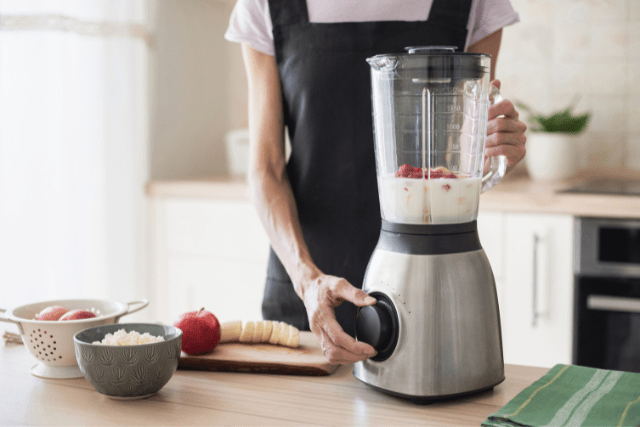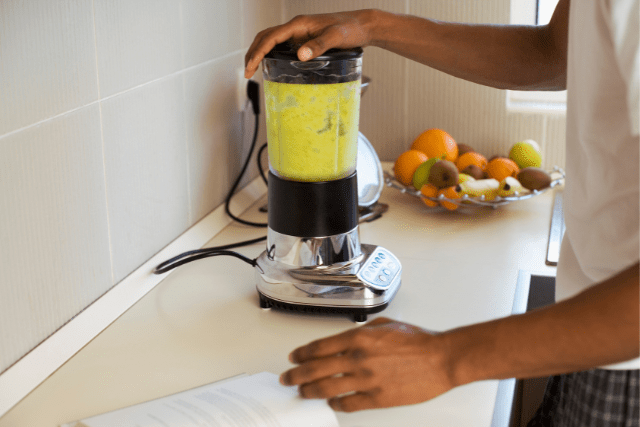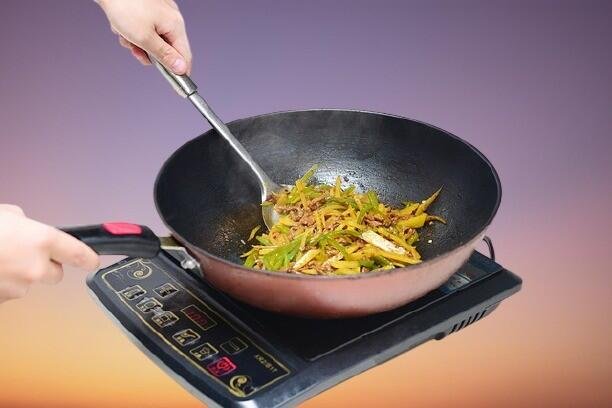Kitchen blenders are an essential appliance for any home cook. They’re perfect for making smoothies, soups, sauces, and more. But like any other appliance, blenders can experience problems from time to time. This blog post will discuss common kitchen blender problems and simple steps to fix them. So whether you’re a novice cook or a seasoned chef, this guide will have you covered.
Common Kitchen Blender Problems and Solutions
From a blender that won’t start to one that leaks or won’t blend properly, these issues can be frustrating and prevent you from enjoying a delicious smoothie or homemade soup. But don’t worry; these common blender problems can be easily fixed with a few simple steps.
Problem: Blender Won’t Start
One of the most common kitchen blender problems is a blender that won’t start. A variety of issues can cause this, but there are a few simple steps you can take to fix it.

Step 1: Check the Power Cord
The first step is to check the power cord. Make sure it’s plugged in, and the outlet is working. If the cord is damaged, frayed, or bent, it may need to be replaced.
Step 2: Check the Blender’s Switch
If the power cord is OK, then check the blender’s switch. Make sure it’s in the on position. If the switch is faulty, it may need to be replaced.
Step 3: Check the Blender’s Motor
If the switch is OK, the problem may be with the blender’s motor. If the motor is faulty, it may need to be replaced.
Problem: Blender Leaks
Another common kitchen blender problem is a blender that leaks.
Step 1: Check the Blender’s Gasket
The first step is to check the blender’s gasket. If the gasket is damaged or worn, it may need to be replaced.
Step 2: Check the Blender’s Lid
If the gasket is OK, then check the blender’s lid. Make sure it’s tight and secure. If the lid is damaged or worn, it may need to be replaced.
Step 3: Check the Blender’s Blade
If the lid is fine, then check the blender’s blade. Make sure it’s tight and secure. If the blade is damaged or worn, it may need to be replaced.
Problem: Blender Won’t Blend Properly
Another common kitchen blender problem is a blender that won’t blend properly.
Step 1: Check the Blender’s Blade
The first step is to check the blender’s blade. Make sure it’s tight and secure. If the blade is damaged or worn, it may need to be replaced.
Step 2: Check the Blender’s Motor
If the blade is OK, then check the blender’s motor. Make sure it’s working correctly. If the motor is faulty, it may need to be replaced.
Step 3: Check the Blender’s Speed
If the motor is fine, then check the blender’s speed. Ensure it’s set to the proper speed for the task. If the speed is set too high or too low, it can cause the blender not to blend properly.
Problem: Blender blades are dull
Another common kitchen blender problem is a dull blade.

Step 1: Check the Blender’s Blade
The first step is to check the blender’s blade. Make sure it’s tight and secure. If the blade is dull or damaged, it may need to be replaced.
Step 2: Clean the blade
If the blade is not damaged but dull, it could be dirty, you can clean the blade using a brush or a toothpick to remove any stuck-on food particles.
Step 3: Sharpen the blade
If the blade is still dull after cleaning, it may be necessary to sharpen the blade. You can use a honing steel to sharpen the blade.
Problem: Blender motor is overheating
Another common kitchen blender problem is an overheating motor.
Step 1: Check the Blender’s Motor
The first step is to check the blender’s motor. Make sure it’s working properly. If the motor is overheating, it may need to be replaced.
Step 2: Check the Blender’s Ventilation
If the motor is fine, then check the blender’s ventilation. Make sure it’s not blocked. Blocked ventilation can cause the motor to overheat.
Step 3: Check the Blender’s Power
If the ventilation is fine, then check the blender’s power. Make sure it’s not running on too high of a speed for an extended period of time. This can cause the motor to overheat.
Problem: Blender smells burnt
Sometimes a kitchen blender produces a burnt smell.
Step 1: Check the Blender’s Motor
The first step is to check the blender’s motor. Make sure it’s working properly. If the motor is overheating, it may need to be replaced.
Step 2: Check the Blender’s Power Cord
If the motor is OK, then check the blender’s power cord. Make sure it’s not frayed or damaged. A damaged power cord can cause the motor to overheat and produce a burnt smell.

Step 3: Check the Blender’s Control Panel
If the power cord is fine, then check the blender’s control panel. Make sure it’s not damaged. A damaged control panel can cause the motor to overheat and produce a burnt smell.
Problem: Blender is making strange noises
Another common kitchen blender problem is strange noises.
Step 1: Check the Blender’s Blade
The first step is to check the blender’s blade. Make sure it’s tight and secure. If the blade is loose, it can cause strange noises.
Step 2: Check the Blender’s Motor
If the blade is fine, then check the blender’s motor. Make sure it’s working properly. If the motor is faulty, it can cause strange noises.
Step 3: Check the Blender’s Base
If the motor is fine, then check the blender’s base. Make sure it’s not loose or damaged. A loose or damaged base can cause strange noises.
Problem: Blender is vibrating excessively
Another common kitchen blender problem is excessive vibration.
Step 1: Check the Blender’s Blade
The first step is to check the blender’s blade. Make sure it’s tight and secure. If the blade is loose, it can cause excessive vibration.
Step 2: Check the Blender’s Motor
If the blade is fine, then check the blender’s motor. Make sure it’s working properly. If the motor is faulty, it can cause excessive vibration.
Step 3: Check the Blender’s Base
If the motor is fine, then check the blender’s base. Make sure it’s not loose or damaged. A loose or damaged base can cause excessive vibration.
Problem: Blender container is cracked or broken
Another common kitchen blender problem is a cracked or broken container.
Step 1: Inspect the container
The first step is to inspect the container. Look for any cracks or breaks in the plastic. If the container is cracked or broken, it will need to be replaced.
Step 2: Check for warping.
If the container appears to be in good condition, check for warping. Warping can cause leaks and make it difficult for the blender to function correctly.
Step 3: Check for proper installation.
If the container is in good condition and not warped, ensure it is correctly installed. A loose or improperly installed container can cause leaks and damage to the blender.
Problem: Blender speed control is not working properly
Another common kitchen blender problem is speed control not working correctly.
Step 1: Check the Blender’s Speed Control
The first step is to check the blender’s speed control. Make sure it’s not damaged or broken. If the speed control is damaged, it will need to be replaced.
Step 2: Check the Blender’s Motor
If the speed control is OK, then check the blender’s motor. Make sure it’s working correctly. If the motor is faulty, it can cause the speed control not to function correctly.
Step 3: Check the Power Cord
If the motor is OK, then check the blender’s power cord. Make sure it’s not frayed or damaged. A damaged power cord can cause the speed control not to function correctly.

Finding the right parts for your blender
Finding the right parts for your blender ensures proper function and longevity. When looking for replacement parts, it’s essential to make sure they are compatible with your specific blender model. Here are some steps to help you find the right parts for your blender:
Check the manual
The first step is to check the manual that came with your blender. It should list the specific parts that are compatible with your model. If you no longer have the manual, you can usually find it online by searching for the model number of your blender. This manual will contain important information on the parts of your blender and how to replace them.
Identify the part
Before you start looking for replacement parts, you need to identify the specific part that needs to be replaced. If you’re unsure, consult the manual or the manufacturer for guidance. Make sure you have the correct part’s name, number, or description. It would be helpful to have a picture of the part you need to replace to help with the identification process.
Search online
Once you know the specific part, you can search online for retailers that sell compatible parts. Many online retailers have a search function that allows you to find parts based on your blender’s model. Online retailers such as Amazon and Walmart offer various parts for different brands and models of blenders.
Check the warranty
Before you buy replacement parts, check the warranty on your blender. Some manufacturers may offer free or discounted replacement parts for a certain period. Additionally, some manufacturers may have a dedicated customer service department that can assist you in finding the correct parts for your blender.
Compare prices
Once you’ve found a few retailers that sell the part you need, compare prices to find the best deal. Remember that the cheapest option may not always be the best quality, so read customer reviews before making your purchase.
Order the part
Once you’ve found the right part at the right price, place your order and wait for the part to arrive. Check the estimated delivery date and keep an eye on the tracking information.
Replace the part
Once you receive the part, refer to the manual or instructions provided by the manufacturer for instructions on how to replace it. If you’re unsure how to replace the part, contact the manufacturer or a professional.
Using your blender safely.
Using your blender safely is crucial to ensure that you don’t get hurt while using it and to prevent accidents or damage to the blender. Here are some tips to help you use your blender safely and also solve most of the above-discussed common kitchen blender problems.

Read the manual
Before using your blender, take the time to read the manual that comes with it. The manual will contain important safety information and instructions on correctly using your blender. Not only will it help you to avoid accidents, but it will also help to prolong the life of your blender.
Handle the blades with caution
The blades of a blender are sharp, so it’s essential to handle them with caution. Unplug the blender first and use a brush or a soft cloth when cleaning the blades. Avoid using sharp objects such as knives or scissors to clean the blades, as this can cause damage.
Secure the container properly
Before blending, ensure the container is correctly attached to the blender’s base. This will prevent accidents such as spills or the container coming loose during blending. Ensure the locking mechanism is securely in place and the container correctly aligns with the base.
Use the right ingredients.
Some ingredients, such as hot liquids or large chunks of ice, can be dangerous when blended. Make sure to use safe ingredients for your blender and appropriate for your blending. For example, if you’re blending hot liquids, make sure that your blender is designed to handle them.
Start on low speed
When blending, start on a low speed and gradually increase it. This will prevent splatters and spills and ensure that the ingredients are blended evenly. Avoid starting your blender at high speed, as this can cause a mess and make it difficult to control the blending.
Use the lid plug
Many blenders come with a lid plug, which can add ingredients while the blender is running. Use this feature to avoid having to take off the lid during blending, which can be dangerous. It also allows you to add ingredients gradually and achieve the desired consistency.
Don’t overfill the container.
Overfilling the container can cause spills and make it difficult for the blender to function correctly. Make sure to follow the manufacturer’s instructions on how many ingredients to put in the container, and leave some space at the top to allow the ingredients to blend properly.
Keep children away
Make sure that children are not around while the blender is in use. Blenders can be dangerous, and children may not be able to handle them properly. Keep an eye on your children when using your blender, and ensure they are not near the blending area.
Turn off the blender.
When you’re done blending, please turn off the blender and unplug it before removing the container. This will prevent the blender from starting accidentally and ensure that the blades have stopped spinning.
The importance of investing in a high-quality blender
Investing in a high-quality blender is essential for several reasons. Not only does it provide a better performance, but it also ensures that your blender will last longer and be less prone to problems.

Here are some benefits of investing in a high-quality blender:
Built to Last
Durability is one of the most important benefits of investing in a high-quality blender. High-quality blenders are made with better materials, which means they are built to last. This means that you won’t have to replace your blender as often, and you’ll save money in the long run. Not only that but a durable blender guarantees that it will keep working for a long time and can handle any blending task you throw at it.
Powerful Motors
Performance is another crucial benefit of investing in a high-quality blender. High-quality blenders come with more powerful motors, which means they can handle tough ingredients and produce smoother blends. This is especially important if you blend hard ingredients like ice, frozen fruits, and nuts. With a more powerful motor, you can surely achieve a perfectly blended smoothie or soup every time.
Variety of Features
Features are also an essential aspect of high-quality blenders. High-quality blenders often come with various features such as variable speed control, pulse function, and multiple blades. These features give you more control over your blending and make achieving perfect consistency easier. Whether looking for a smoother or chunkier blend, you can adjust the speed and pulse settings to achieve the perfect result.
Safety Features
Safety is also a top concern when investing in a high-quality blender. High-quality blenders often come with safety features, such as safety switches, that prevent the blender from operating if the container isn’t properly attached. This essential feature ensures that your blender won’t start working if the container isn’t attached properly, which can prevent accidents and injuries.
Better warranty
Warranty is an essential aspect to consider when investing in a high-quality blender. High-quality blenders usually come with a better warranty, which means that if something goes wrong, you can get it fixed or replaced at no extra cost. This can save you money and hassle in case of breakdowns or problems and gives you the peace of mind that comes with knowing that your blender is covered.
Guarantees Quality
Lastly, investing in a blender from a reputable brand guarantees that you’re getting a quality product and that you can benefit from the brand’s customer service and warranty. A reputable brand will ensure that you’re getting a high-quality blender that will last for years to come and that you can rely on its customer service in case of any issues. By sticking to the same brand for your blender, you can be sure that the parts and accessories you buy will be compatible and work well.
So, investing in a high-quality blender may cost more upfront, but it is worth it in the long run. With better performance, durability, features, and warranty, a high-quality blender will save you money and hassle in the long run. It also ensures that you have a blender that can handle any blending task you throw at it and will be less prone to problems and breakdowns. Plus, you’ll have peace of mind knowing that you have a quality product backed by a solid warranty.
Conclusion
Kitchen blenders are helpful in any home, but like any other appliance, they can experience problems. The common kitchen blender problems were discussed in the above article, with the necessary steps to solve them. So one can fix them quickly. It’s always advisable to keep the blender clean and maintain it regularly to avoid breakdowns. If you’re unable to fix a problem, it may be time to consider buying a new blender. With these simple steps, you’ll be back to blending in no time.







